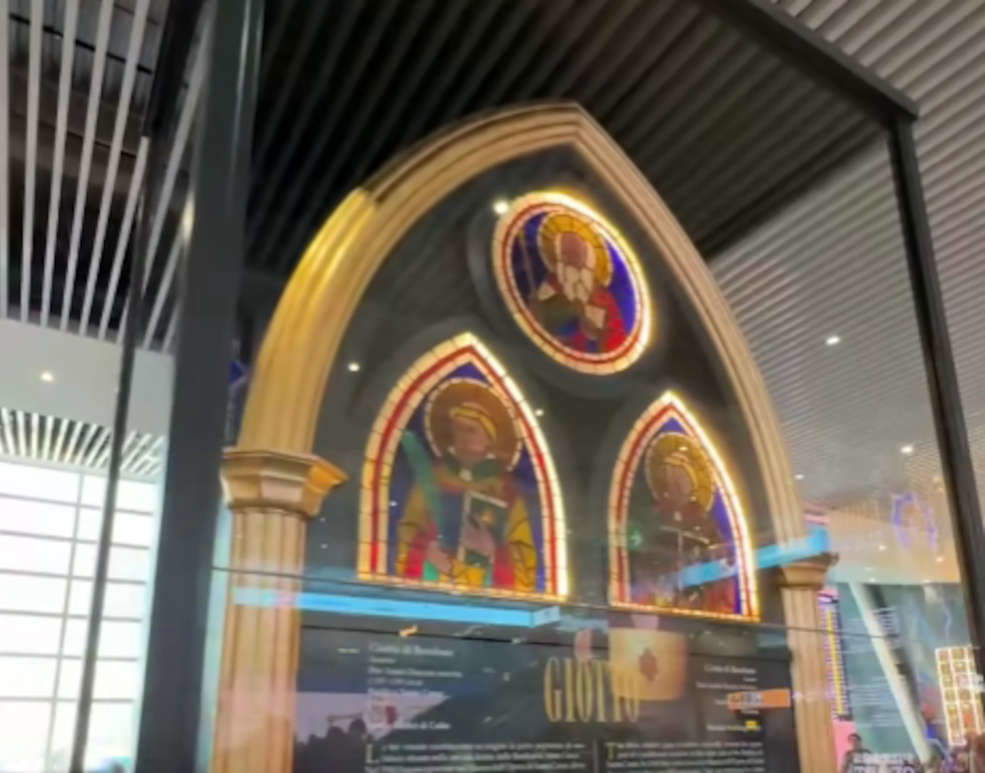Giotto at the airport? The real issue is our relationship with heritage
I am asked by “Finestre Sull’Arte” for an opinion on the display at Fiumicino airport of three large panels of the stained-glass window that originally stood at the end of the right aisle of the Basilica of Santa Croce in Florence. Erratic panels that a leading art historian of the century that has just ended, Miklos Boskovits, attributed to Giotto a few years ago, and which are now being displayed in that wholly unusual place in order to entice “the millions of passengers - so it was said - who pass through that airport to visit Italy.” Let us say right away, then, that those panels skip in one step what is the first and true form of enhancement of our heritage. Its conservation in relation to the environment. And I say this referring to the preservation of the totality of the heritage, knowing full well that those fragile stained glass windows are in no danger because they are kept in unbreakable cases and proof of the dementia of environmentalist vandals. Which means that there are other questions we need to ask ourselves with respect to this matter.
Let’s stay with conservation. Since no minister, superintendent, regional official or university professor has so far implemented a programmed conservation plan for heritage in relation to the environment that would follow the one implemented by the Central Institute for Restoration after theflood of Florence in 1966 one must conclude that travelers in Fiumicino do not enjoy the enhancement intended as heritage conservation, but rather see those stained glass windows as the display of works by Giotto no longer in the Uffizi or Vatican Museums, but on the backdrop of an airport terminal. Hence the conclusion that those travelers are a variant of the unseen “tourist termites” who damage heritage no longer in physical terms, but with a lack to the respect, quietness and worship that our fathers had taught us we should have for works of art, even more so when honored with glory as those of the Florentine master are. But if this is the case, as in fact it is, we need to reflect on this phenomenon. For example, reflect on the basis of the reasons why Giovanni Urbani in 1972, half a century ago, wrote that: "As long as one thinks that cultural assets find their place in environmental policy, perhaps only as a tourist attraction, one is far from understanding what they are really for.


Cultural assets-the ancient cities, the man-made landscapes, the works of art that still subsist in their original location-are practically the environment, or rather, they are the only possible environment for the man of the ’Human Sciences’: that man who can decide for himself on the finite plane of Nature only if he makes co-present to himself, to his actuality, his past and his future-which is the only way to make his ’cultural becoming’ a fact homogeneous with Nature."
A very lucid cameo, this one by Urbani, which commits environmentalism to a moral and ethical responsibility different from “let’s save the white seal” or electric cars with bursting lithium batteries, taking us from Fiumicino to the whole of Italy understood as the nation that boasts a ratio of artistic heritage to the environment that is unique in the world, in terms of vastness and quality. Which confronts us with another and different question. To ask whether there is a difference between the travelers who leave Fiumicino passing in front of Giotto’s stained glass windows compared to the hundreds of thousands of people who assault not only the Italy of museums and exhibitions on weekends, but also its landscapes: the crowds that get off the big ships and invade the Cinque Terre, so many that they have forced local police to invent never-before-seen alternating pedestrian one-way directions. All tourist termites? But still, wanting to rage, is it decent for the state to entrust insects that are no longer isopterous but bipedal, i.e., museum and landscape assailants, with the task of balancing part of the state budgets? Or are we facing the sad sell-off of an ultra-millennial historical, artistic and human civilization that we no longer know what to do with? It is easy to answer that things are a pretty much like that. But not entirely if one does not answer a subordinate to what has been said so far. For it remains to be explained why crowds of people willingly occupy the historic centers of so-called art cities and their museums, but also their landscapes, as has just been said of the Cinque Terre, and why they do so despite the fact that they are all or most unaware of the historical and cultural reasons for what they look at. For example very likely, when not certain is that if the stained glass windows of Fiumicino are really by Giotto it is only their design drawing and not their execution in color. In fact, it was common practice, as Lorenzo Ghiberti recounts in the mid-15th century, for artists to execute designs and for others then to put them in color on panels, stained-glass windows, banners, embroidery, or make sculptures of them. Are then the hundreds to hundreds of thousands of tourists mere epiphenomena of the mass protagonism that characterizes our difficult time, that of social onanists, TikTok or selfies taken at the funeral of the star as of the Minister or the Pope to send them to friends and so on?
A question not easy to unfold, which nevertheless still finds a good answer today in a passage from the “Reith Lectures” given in 1960 at the BBC by one of the great cultural historians of the last century, Edgar Wind, those confluent in the capital volume “Art and Anarchy.” A text in which the Berlin-based art historian as early as 1960 fielded the question of what lesson art, especially contemporary art, left for the public: “What should our art economy do to avoid both excess and atrophy? I do not intend to put this question to art historians. My question is about the public [...]. I have heard eminent and intelligent men discuss Art and Society, or Art and the State [...]. For them, the fundamental argument was that the greatest possible dissemination of art can only produce benign and civilizing action. [But true is that, for science,] one of the consequences of its diffusion is the loss of density. So that today, if a person has the time and means, he can attend a retrospective exhibition of Picasso in London one day, and an exhibition of the whole of Poussin in Paris the next; and the most astonishing fact is that the person in question is able to fully enjoy both events. When such comprehensive exhibitions of mutually incompatible artists are received with equal interest and identical favor, it is clear that the public that flocks to them has now developed a strong immunity to the exhibitions. Art is so well accepted because it has lost its sting [that of anarchy]. I think many [museum directors] today are aware-though not all are so unwise as to confess it-that they are addressing an audience whose increasingly insatiable appetite for art is offset by a progressive atrophy of the receptive organs. If art sometimes shrieks, it is not the fault of the artist alone. We all tend to raise our voices when we address people who are going deaf.”
Warning: the translation into English of the original Italian article was created using automatic tools. We undertake to review all articles, but we do not guarantee the total absence of inaccuracies in the translation due to the program. You can find the original by clicking on the ITA button. If you find any mistake,please contact us.




























